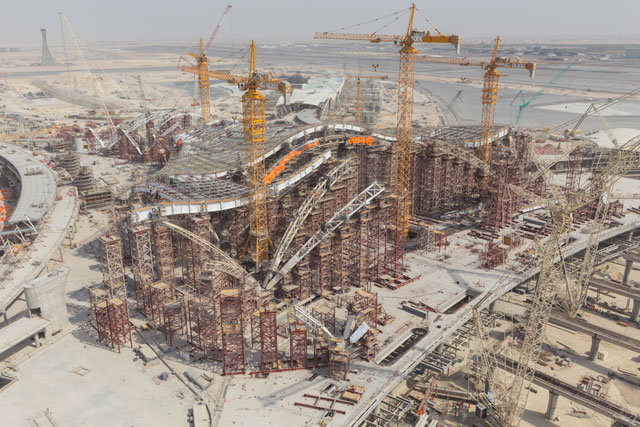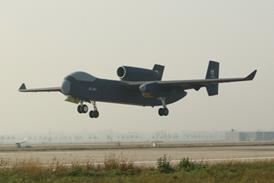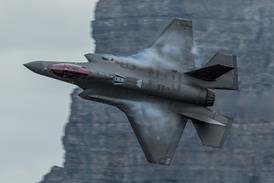Airport investment is in overdrive at aviation’s busiest global crossroads, as the hubs of Emirates, Etihad and Qatar Airways vie to keep pace with the growth of their flag-carriers, and with eachother to attract international air traffic. While Doha’s new Hamad International is about to embark on an expansion that will take throughput to almost 70 million passengers by 2020, Abu Dhabi is close to transforming its airport with the completion of its giant new Midfield terminal.
Meanwhile, Dubai is trying to squeeze more capacity out of what is now the world’s busiest international airport before its multi-runway Dubai World Central replacement comes fully on stream in the mid-2020s. Such is the growth of Emirates, that existing plans by Dubai Airports to restrict Dubai International’s capacity to 90 million have already been scrapped as it looks for innovative ways to accomodate nine-figure passenger numbers within a relatively tight piece of land.

Forecasts of Dubai International's capacity limit have had to be revised upwards
imageBROKER/Rex Shutterstock
Although no other Gulf carriers have aspirations to join the big three club, elsewhere in the region airport expansion is under way. In Oman, Muscat International’s new terminal will open in early 2017, nearly doubling capacity to 12 million. Further down the coast, Bahrain is inviting bids for a contract to build a terminal able to handle 14 million passengers by 2030, a 75% increase on what the airport handles today, while Kuwait is also planning to develop a new passenger terminal.
Two years ago, Abu Dhabi’s Midfield terminal was a hole in the desert between the airport’s two runways, with only cranes and construction traffic visible from the nearby highway to Dubai. Since then, a 60m-high structure has risen from the ground and is about 70% complete. Due to open at the end of 2017, the 65-gate terminal – eight gates Airbus A380-compatible – will more than double capacity at the airport to 45 million passengers.
The six-storey building will serve as a hub for Etihad and its partners, with other airlines moving to the existing terminals one and three, which will be connected by a road tunnel. The architecture of the 65m-high edifice is impressive, with a curved roof suspended on arches giving the impression that it is floating, and each of the four piers with its own colour scheme. Sulaiman Siksik, chief project officer for ADAC, describes it as “one of the most complex buildings ever designed”.
The main purpose of the Midfield terminal is to impart a seamless experience to Etihad’s passengers, particularly those on premium tickets, says Siksik. There will be up to eight lounges as well as an airside hotel. As with the other Gulf connectors, the majority of Etihad passengers are transiting, and the airline is committing to a minimum connecting time of 45 minutes between gates. Long term plans include the addition of a satellite terminal.
While Abu Dhabi’s plans for its international airport are ambitious, its neighbour Dubai’s dreams remain almost off the scale. A decade ago it began building – just an hour’s drive north of Abu Dhabi International – what was intended to become by the early 2020s the world’s biggest passenger and freight hub. Dubai World Central (DWC) would comprise a six-runway airport surrounded by a new city in the desert south of Dubai, connected to the Jebel Ali port and free zone.
The city’s financial crisis of 2009/10 slowed the project, but DWC has slowly come to life. It has become the main cargo airport for Dubai and one of the world’s top 20 freight hubs. Also, following the opening of a passenger terminal in 2012, several airlines have set up operations there. They include Wizz Air, Qatar Airways and Gulf Airways. Even Emirates’ sister airline Flydubai offers 70 flights a week from there, to cities it also serves from Dubai International.
That said, DWC is still a long way from being the global gateway originally intended, as Dubai Airports chief executive Paul Griffiths concedes. Despite a planned extension to the terminal to take capacity to 26 million by 2017, it would have to grow another sixfold at least to be sufficient for Emirates to move its fast-growing operation to the new airport. “DWC has a gestation of 10 years, so moving Emirates there before 2025 is remote,” he says.
This leaves Dubai Airports with a quandary. Dubai International (DXB) became the world’s number one for international passengers in 2013, with numbers exceeding 70,000. Since then the figure has increased to “just shy of 80 million” – three quarters of it Emirates and Flydubai. Even though freight traffic and most business aviation traffic has been relocated to DWC, demand for space and slots threatens to outstrip what Griffiths and his team can provide.
“Growth has exeeded expectations. Every time we re-forecast, we revise up,” he says. “Everyone wants a slice of Dubai capacity”. Passenger numbers are in line to 100 million by 2020 – with a further 26 million using DWC – and Griffiths admits: “We’re scratching our heads to see how we can accommodate that. Our throughput is unprecedented. Per square metre of airfield, our throughput is of a different order of magnitude to most airports.”

Midfield will double Abu Dhabi's capacity
ADAC
New infrastructure projects will help. With its perimeter ringed with busy roads and buildings – many of which were there when Dubai was a small trading port – DXB cannot grow outwards. This has meant every available piece of land within the fence is used, with older buildings frequently dismanted to create more room. A new concourse, D, serving airlines using the 1970s era terminal one, will open around the turn of the year, and make things less crowded for passengers.
Another solution could be to persuade more of the second- and third-tier airlines – many of which use DXB’s low-cost terminal two – to follow Flydubai’s example and relocate at least some of their flights to DWC. “If you want slots at the moment, you can get them there,” he says. “It’s all about critical mass. Airline planners tend to be a conservative lot, but once they see others operating successfully there, they will be persuaded.”
In Doha, Hamad International, which opened in mid-2014 after several delays, is getting into its stride, although Qatar Airways Group chief executive Akbar Al Baker – the airport’s biggest user by far – admits there are still “teething problems”. The development, 4km from the old Doha International, was highly ambitious, with 60% of the land on which it was built reclaimed from the sea, and designers expected to deliver on characteristically high expectations from its anchor tenant.
A second phase, about to begin, will add capacity, with new concourses taking passenger numbers from almost 29 million last year – including around six months during which Doha International was open – to beyond 35 million this year, says Al Baker, with Qatar Airways accounting for around 30 million of that number. The extension – designed by UK architect Sir Norman Foster – will take capacity to almost 70 million by the end of the decade.
With squash courts, sleeping lounges and a swimming pool as well as two 100-room airside hotels and a shopping mall, Qatar has certainly set the bar high when it comes to Gulf airports. One newspaper has dubbed Hamad International “the most over-the-top airport in the world”. However, Al Baker has simply said of his airline’s new home: “I don’t think there is any airport of this standard anywhere.”
Get all the lastest news, analysis and opinions from Dubai Airshow on our dedicated landing page
Source: Flight International




















